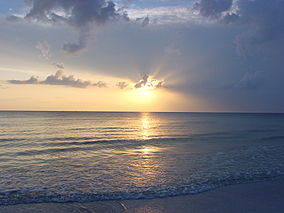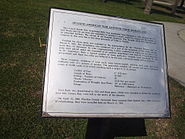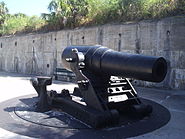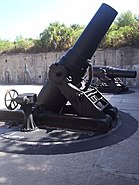| Fort De Soto Park | |
|---|---|
|
IUCN category V (protected landscape/seascape) | |
 Sunset at North Beach in Fort De Soto Park | |
| Location | Pinellas County, Florida, USA |
| Nearest city | St. Petersburg |
| Coordinates | 27°36′56″N 82°44′09″W / 27.615499°N 82.735902°WCoordinates: 27°36′56″N 82°44′09″W / 27.615499°N 82.735902°W |
| Established | December 21, 1962 |
| Governing body | Pinellas County |
Fort De Soto Park is located just outside the city of St. Petersburg, Florida. This park, operated by Pinellas County, is made up from five offshore keys, or islands lying to the city's south-southwest: Madelaine Key, St. Jean Key, St. Christopher Key, Bonne Fortune Key and the main island, Mullet Key. Today all are connected by either bridge or causeway to each other. The island group is accessible by toll road from the mainland..
The park is a 'gateway site' for the Great Florida Birding Trail.
History[]

Interior of Battery Laidley
In 1849, Brevet Col. Robert E. Lee (the famous American Civil War commander) and three other US Army Engineers surveyed the area and recommended Mullet and Egmont Keys become fortified. Both keys could only be reached by boat, since they were islands off the mainland. Union troops were stationed on the two keys during the Civil War (1861–1865) to aid in the Union blockade of Tampa Bay. The keys were again abandoned by the military until 1882 when military reservations were officially created on the two keys. However, it would be several years before actual permanent construction would commence as a result of defense considerations linked to the Spanish-American War.
Hillsborough County established a quarantine station on the eastern side of Mullet Key in 1889. It became known as Mullet Key Quarantine Station. The Marine Hospital Service took over jurisdiction of the station in 1901. The duty of the station was to inspect aliens aboard ships arriving from foreign ports. By 1925 the station operated with fifteen buildings. The quarantine station operated until 1937, when the Public Health Service transferred its operations there to Gadsden Point, near Tampa.
The main operation on Mullet Key, however, became Fort De Soto in 1900, named for Spanish explorer Hernando de Soto. The Army post was officially a subpost of Fort Dade, which was constructed on Egmont Key. These posts were to contain batteries of artillery and mortars to protect Tampa Bay from any invading forces. Construction of Fort De Soto began in November 1898 and was completed in 1906. The foundation was constructed of a shell concrete formula and the walls and ceiling used a shell, stone and concrete mix. The main attractions at the completed post were the artillery and mortar batteries, Batteries Laidley and Bigelow. The post consisted of 29 buildings. The post's features included a large barracks, a hospital, a guardhouse, a blacksmith and carpenter shop, an administration building, and mess hall with kitchen, a bakery, and a storehouse. The site also had brick roads, concrete sidewalks and a narrow-gauge railroad to aid in moving materials and supplies around the post.
The post was active from 1898 to 1910. At least one company was present at Fort De Soto at all times and many times several units were present. Mosquitoes were a constant problem and the post was very hot in the summers. In 1910 most troops were moved to Fort Morgan in Alabama. Only a caretaker force remained. By 1914 only a sergeant and game warden remained at the post. Through most of World War I a larger caretaker force was at the post, usually with about 22 privates, two noncommissioned officers and two commissioned officers. In 1917 four of the post's mortars were disassembled and shipped to Fort Rosecrans, in San Diego, California.

Two of the four 12-inch M1890-M1 mortars
In November 1922 the Army announced it would soon close both Forts De Soto and Dade. On May 25, 1923, the forts were officially abandoned and only one caretaker remained at each post. A number of tropical storms and hurricanes severely damaged the buildings on the post. A few were destroyed, as was Battery Bigelow in 1932. The Army attempted to sell the post, but there was little interest. In September 1938 Pinellas County bought the areas on Mullet Key for $12,500.
Two years later the War Department decided it wanted Mullet Key back for use as a bombing range by the U.S. Army Air Corps. In June 1941 the key was purchased back from Pinellas County for $18,404 and turned into a subpost of MacDill Field. In 1948 Pinellas County again purchased the key and it permanently remained county property.
In 1962 a toll road, the Pinellas Bayway (formerly State Road A19A, now SR 682), was completed to the mainland, enabling island visitors to arrive by car. On December 21, 1962, Fort De Soto Park opened. On May 11, 1963, Fort De Soto Park was officially dedicated. Its facilities have been expanded over the years. The quartermaster storehouse was reconstructed to become the Quartermaster Storehouse Museum. On December 2, 1977, the Fort De Soto batteries were placed on the National Register of Historic Places.
In 2003, a portion of the Marvel comic-inspired film "The Punisher" was filmed on Mullet Key and Fort Desoto as a mock-up of Puerto Rico.
Early History[]
The area of Fort Desoto for over 400 years has attracted a variety of visitors. Among the earliest was the Tocobaga Indians who preceded Spanish explorers which begin the westerns world entrance into the area. On April 15, 1528, Panfilo de Narvaez landed on the shore of the west coast of Florida between St. Petersburg Beach and Clearwater. This Spanish explorer with a group of conquistadors explored the barrier islands in the area. This area was further explored on May 30, 1539, when Hernando De Soto arrived on the shores of Tampa Bay.
Recreational activities and amenities[]

Fishing pier juts out into the Gulf of Mexico

One of Fort De Soto Park's lauded beaches
The park is open year-round and has the following features:
- Several thousand acres of firm-bottomed shallows, making the area a favored destination of wading anglers
- Two piers, each allowing fishing. Both have bait, tackle and food concessions.
- Various picnic areas.
- Fort De Soto, built in 1898, abandoned in phases 1910 to 1948.
- Quartermaster Storehouse Museum.
- Two swimming areas, North Beach and East Beach. North Beach has been named to America's Top 10 Beaches list by DrBeach.org numerous times. In 2005 it moved to the first place in this list, being recognized as the top beach in the nation.
- 800-foot boat ramp.
- Camping area with a camp store, modern restrooms and laundry room.
- Snack bar with gift shop at the old fort.
- Seven-mile multi-purpose trail.
- 2¼ mile canoe trail.
- Barrier-free nature trail.
- Paw Playground, an area to exercise pets.
- Ferry to Egmont Key, site of Egmont Key State Park.
Gallery[]
See also[]
References[]
External links[]
- Pinellas County listings at National Register of Historic Places
- Florida's Office of Cultural and Historical Programs
- Fort De Soto Park - official site
- FortDeSoto.com - A site dedicated to Fort De Soto Park
- Laboratory for Coastal Research & National Healthy Beaches Campaign, Florida International University
The original article can be found at Fort De Soto Park and the edit history here.

















